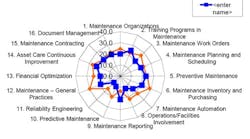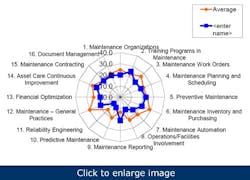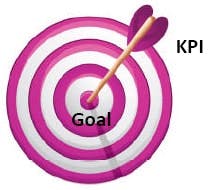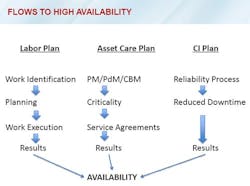5 steps on the path to maintenance superiority
In brief:
- What are the important steps required to move from current performance to maintenance excellence?
- Understand the company goals that get translated down to maintenance or that maintenance can influence by improved performance.
- If you aren’t delivering the results desired now, then you must make changes.
Maintenance is easy, but not simple. It’s not nuclear physics, but the large number of moving parts means that maintenance performance often falls short of what’s needed by operations.
But in what way is it easy? Let’s look at excellent lubrication. It’s delivering the right lubricant to the right spot and following the right procedure at the right time. What’s more, almost all of the information about lubrication is readily available. Why isn’t it simple? Other priorities often interfere with the lubrication schedule. The environment or handling procedures introduce contamination, the location is sometimes hidden or not labeled, and the people doing the work are often not properly trained. All of the same kinds of issues apply to preventive maintenance, predictive maintenance, and corrective maintenance. To achieve maintenance excellence, each of these activities must be done with excellence.
What are the important steps required to move from current performance to maintenance excellence?
- Perform an assessment.
- Work on achieving collaboration.
- Build a business case.
- Execute the improvement project plan.
- Check results and make adjustment.
As you begin, take the time to understand the company goals that get translated down to maintenance or that maintenance can influence by improved performance. Make sure you understand which results maintenance must deliver to be a partner in achieving operational results. If you aren’t delivering the results desired now, then you must make changes. Fundamentally, work processes deliver the results they’re designed to deliver. Operations personnel clearly understand this relationship, but sometimes it isn’t as clearly understood by maintenance workers. If you’re unhappy with current results, you must make changes. Simply working harder will not do the job.
Assessment
An old Chinese proverb says that a journey of a thousand miles begins with the first step. The first step in the journey to maintenance excellence is to understand where you are right now. This means that you must do an assessment of your maintenance practices. There are many ways to do an assessment, but it must be a detailed, structured process that looks at the entire maintenance work process. These areas should be covered.
- maintenance organization
- training
- work order system
- planning and scheduling
- preventive maintenance
- inventory and MRO purchasing
- maintenance automation
- operations/facilities involvement
- reporting
- predictive maintenance
- reliability improvement process
- maintenance general processes
- financial controls
- continuous improvement
- contracting process
- document management.
Select the areas where improvement is needed and begin to develop a survey that will capture critical data (Figure 1). Look at key performance indicators (KPIs) to see what performance is being achieved and where improvement may be needed. Follow the work process and document it to gather data on what might be changed to reduce the time and to improve the results of the work process. Develop questions that will help you understand how the area is managed and how it interfaces with other work processes or other parts of the organization. Once you have a solid data gathering process, you’ll need to gather the data.
Figure 1. In the assessment phase, select the areas where improvement is needed and begin to develop a survey that will capture critical data.
It’s necessary to communicate to all stakeholders about what you’re doing, why you’re doing it, and what you plan to do with the data. Stakeholders include technicians, engineers, staff, operations leadership, purchasing leadership, and finance personnel. Communication is key throughout the assessment, just as change management will be critical once you begin to implement changes.
It is useful to gather benchmark data in the areas of interest. As you gather your organization’s performance, you can compare it to other companies or best in class performance.
The entire assessment process will likely take a few weeks of effort to complete. It’s useful to get some outside eyes on the operation to reduce the bias that often comes from self-assessment. If you have corporate staff or sister plants that are able to help, use them. If not, you might consider getting some outside help. Make sure you gather data from people within each stakeholder area, and ensure those people comprise both the doers and the leaders. This is an important first step. Do it well.
Collaboration
Once you have the assessment data analyzed, you must present the results to all stakeholders. This may be a tough presentation if it contains a lot of bad news. In the presentation, show the areas of biggest opportunities for improvement and what expected benefits exist. This is the beginning of building the one team that must take on this improvement process. To do excellent maintenance, you must have the cooperation of operations and other stakeholders. Work to get a commitment from all stakeholders to support and work on making the recommended improvements. This is selling and may be the hardest part of the job for maintenance professionals. As you are doing this, use the language of the stakeholder wherever possible, so they understand the benefit that they will receive by investing in the improvements. Get agreement on the basic direction and the go-ahead, and then prepare a business case.
Build a business case
The business case is where you turn your findings into dollars. You will need resources to make the changes, and you will need to deliver benefits that can be expressed in dollars. Maintenance excellence is all about protecting the assets, so they have the capacity to deliver products when they’re needed. This often is summarized in the measurement of availability. It’s important that you understand just how much availability is worth to the organization. Look at the availability you found during the assessment and compare it to the current revenue or profit being delivered by your operations. This will give you a starting point to understand how much additional availability might be worth to the company. It’s essential to engage your finance people in this analysis. They can not only provide you with dollars and good models of how much additional capacity is worth, but they also bring the credibility that you’ll need when you go forward with your request for resources. You can indicate basic time frames within your business case, but detailed timing will come later in this process.
You’ll have to follow your company’s internal process for presentation and review for the business case. The end result will be to get permission to go ahead. At this point you’ll have management support and agreement from all other stakeholders for their cooperation.
Develop a project plan
You’ll need to develop a project plan that has key milestones with specific objectives that must be achieved at each milestone. To lower project risk, select an area and implement your plan in a pilot. This will identify problems or missed items before you do an across-the-board rollout. A pilot allows you to work out details and to show other areas that you are delivering something of value. Success in a pilot will likely develop a little pull from other areas so that you don’t have to sell and push as hard. If your plans are complex and long, then you may need to use a project planning software like Microsoft Project and divide the project into phases. There are many good references on how to create and manage projects, so do any necessary research or get help from someone who does a lot of successful projects. Your plans should carefully define what the end results will look like, which KPIs will be used, and who’ll be responsible for the various activities once they’re put into place.
Execute the plan
Execution can be difficult. It’s best to have a dedicated team of people who will work on this project. If you must use a part-time team, then more effort will have to be put into keeping the project on schedule. Use your communication and change management plans and skills to keep everyone informed about progress. Periodic presentations to management are essential to keep everyone engaged and to encourage cooperation.
Assess results and make adjustments
Figure 2. You’re not trying to improve the KPI, you’re trying to improve the work processes by hitting the KPI target.
KPIs are a large area of error and need to be defined carefully. The data needs to be collected carefully and monitored for bias or other inaccuracies.
As you implement improvements, you should begin to see improvements in your KPIs. If you don’t, check the data gathering and fix any issues. Or you may need to modify what you’re doing to help drive improvement. Remember that you’re not trying to improve the KPI, you’re trying to improve the work processes that will be reflected in the KPI. This means that if the KPIs are improving but you don’t see the evidence on the floor, then you need to investigate the KPI and fix it. Keep your eyes on the goals and use the KPIs as indicators of how closely you’re hitting the target (Figure 2).
Always validate your measure of improvement with the affected stakeholder to see if they’re seeing the same improvements. If you’re not going to be able to deliver what you promised, then you need to report that as early and accurately as possible to leadership and stakeholders.
Why should we do this?
Every company must improve its asset availability. Figure 3 shows the drivers that impact availability. Availability improvement allows your plants to, over time, have a lower asset base and will result in a reduced maintenance effort. This leads to an improvement in the company’s cost structure. This can only be achieved by moving away from reactive to more proactive maintenance and higher wrench time. Non-wrench time is potentially wasted effort. Take a look at this example.
Figure 3. Availability improvement allows plants to have a lower asset base, which results in a reduced maintenance effort and leads to an improvement in the company’s cost structure.
Reactive work process
70% reactive work x 70% wasted effort = 49% total waste of maintenance labor
Wasted effort is what you have if you subtract wrench time from total available labor.
Proactive work process
10% reactive work x 40% wasted effort = 4% total waste of maintenance labor
Improving availability is one of the most important areas that maintenance can impact that increases overall equipment effectiveness (OEE). This is your area of contribution to improve competitiveness.
To become more competitive, all parts of the organization must improve performance. The following will be true for everyone.
- Your staffs will be reduced, if not in actual numbers, then in terms of units of output.
- Your cost per unit of output will must be reduced.
- Regulation will increase.
- Technology will change.
- Overall equipment effectiveness must be as good as competitors.
Your staff will likely decline. Even if you don’t have reductions or quits, you will be losing people to retirement. You likely won’t be able to replace them one for one, and, even if you can, you likely won’t find people with the same strong skills that those retirees had. Take a look at your demographics and other issues and begin to plan for personnel needs.
Focus is on cost, and that focus will continue to increase. The customer wants better quality at a lower cost, and loyalty to your company is likely just an analysis of quality, cost, and delivery.
Regulations will continue to increase, and you won’t be given more resources to meet these requirements. Compliance is just a basic expectation of the job.
| Wayne Vaughn is principal consultant at Vesta Partners (www.vestapartners.com). |
Technology will change, and some of this will help you do proactive work more efficiently. It will cost some money, but that will likely have a return on investment. The key hurdle here is that you must make sure your people have the skills to use new technology effectively. Change in this area may also lead to significant changes in who does what between operators, technicians, engineers, and contractors. This, again, is why building that one team from maintenance, operations, and technicians is key.
Your good faith contribution will be to free up some of the resources needed to get this work done. Get higher performance by being smarter. You can’t achieve the desired results by simply working harder. This will take some time. You must continue to repeat to yourself, your staff, your colleagues, and others that maintenance must and will improve to meet the challenges for a better future.



